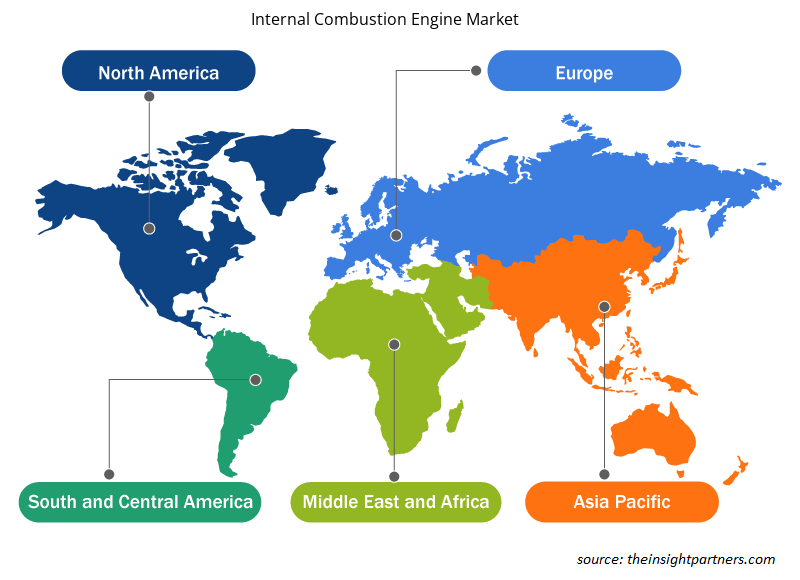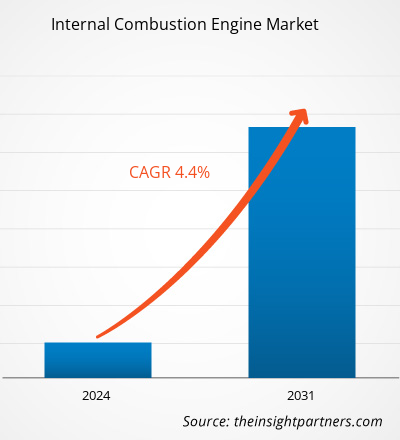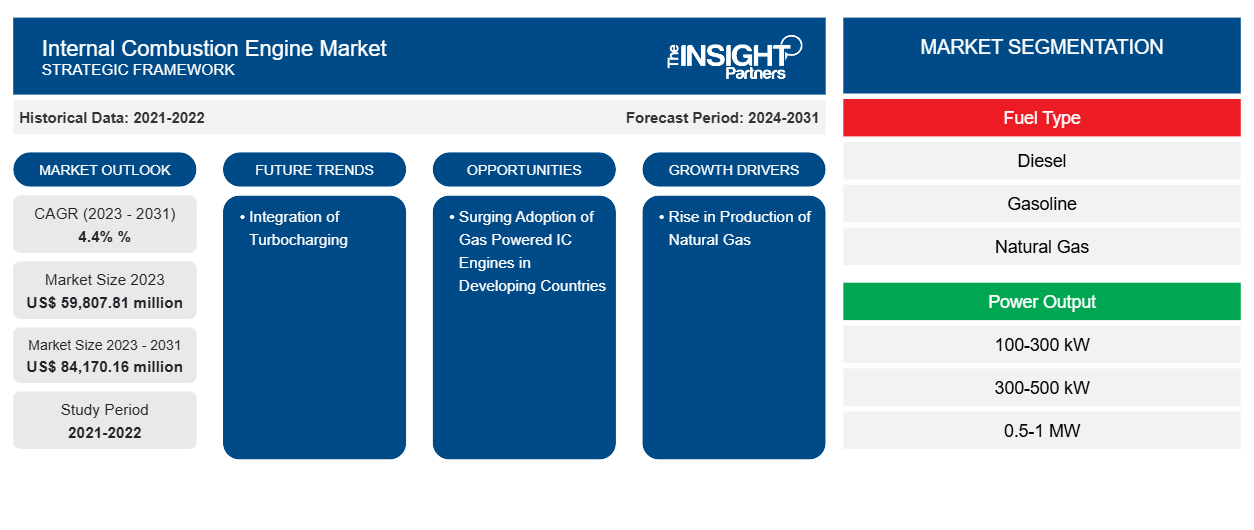内燃机市场规模预计将从 2023 年的 598.0781 亿美元增至 2031 年的 841.7016 亿美元。预计 2023-2031 年市场复合年增长率为 4.4%。工业和商业部门对天然气发电的接受度可能仍是内燃机市场的主要趋势。
内燃机市场分析
金属、食品加工和化工等重工业领域对天然气发动机的需求不断增长,极大地推动了市场的发展。此外,对排放问题的日益关注和监管标准的不断提高也推动了汽车行业的市场增长。在内燃机市场中,汽车、中游石油和天然气、偏远地区、重工业、轻工业、公用事业、越野、数据中心、MUSH 和商业都是最终用户。
内燃机市场概况
全球变暖加剧是世界范围内关注的主要环境问题。各国政府都出台了某些限制措施来控制柴油和汽油发动机的排放;因此,对环保替代品的日益重视迫使发动机制造商开发技术,使内燃机更高效、排放更少。制造商和客户现在将注意力转向在内燃机中应用替代燃料。例如,天然气驱动的内燃机排放更少,但能高效地产生所需的功率。各国的排放监测和监管机构正在对柴油发动机和发电机的使用实施严格的规定。为了满足这些监管标准,许多行业都在使用燃气发动机和发电机来发电。
定制此报告以满足您的需求
您可以免费定制任何报告,包括本报告的部分内容、国家级分析、Excel 数据包,以及为初创企业和大学提供优惠和折扣
-
获取此报告的关键市场趋势。这个免费样品将包括数据分析,从市场趋势到估计和预测。
内燃机市场驱动因素和机遇
天然气产量上升有利于内燃机市场
随着新的排放控制政策的出台,发电行业对燃气发动机的需求正在增加。包括金属、化学品和制造业在内的工业部门是燃气发动机需求不断增长的主要原因。天然气是内燃机所需的一种燃料,其产量正在以显著的速度增长。包括金属、化学品和制造业在内的工业部门是内燃机需求不断增长的主要原因。天然气是内燃机运行所必需的,其产量正在以显著的速度增长。发电、供暖和车辆运行等主要应用正在加强对天然气内燃机的需求。因此,为了解决突然停电的问题,公用事业服务公司正在利用燃气发电机来管理峰值负荷。因此,发展中国家需求的持续激增是推动内燃机市场增长的关键因素之一。
发展中国家燃气发动机使用率不断上升——燃气发动机市场机遇
人口增长和缺乏支持电力技术的基础设施是支持内燃机市场的主要因素。电动设备、电动机、太阳能发电厂和风力发电项目的成本高于燃气发动机,这迫使各国倾向于选择燃气发动机作为环保替代品。此外,柴油发动机排放标准的发展使得各种终端使用行业正在转向燃气发动机以实现低排放。新兴国家实际上倾向于采用天然气发电。因此,天然气日益普及预计将为内燃机市场提供有利可图的机会。
内燃机市场报告细分分析
有助于得出内燃机市场分析的关键部分是燃料类型、功率输出和最终用户。
- 根据燃料类型,内燃机市场分为柴油、汽油和天然气。2023 年,汽油部分占据了更大的市场份额。
- 就功率输出而言,市场细分为 100-300 kW、300-500 kW、0.5-1 MW、1-5 MW、5-15 MW、15-25 MW 和 25 MW 及以上。2023 年,100-300 kW 部分将占据市场主导地位。
- 就终端用户而言,市场细分为工业、船舶、发电、航空航天和国防、汽车、越野等。汽车领域在 2023 年占据了市场主导地位。
- 就气缸而言,市场细分为 1、2、3 和 4。4 缸发动机在 2023 年占据了市场主导地位。
内燃机市场份额按地区分析
内燃机市场报告的地理范围主要分为五个地区:北美、亚太、欧洲、中东和非洲、南美/南美和中美。
亚太地区的内燃机市场分为印度、日本、澳大利亚、中国、韩国和亚太其他地区。中国是该地区领先的内燃机制造国之一,而印度和日本也被认为是该地区增长的重要贡献者。由于印度和中国等发展中国家人口的增加,对电力的需求也不断增加;因此,发电厂、偏远工厂和制造业等终端用户正在利用内燃机发电。由于拥有大量熟练的人力资源,印度和中国的制造公司数量不断增加,其特点是大量生产用于汽车和发电的内燃机。由于电力发动机成本高昂且缺乏配套基础设施,传统内燃机的采用率有所上升,这促进了市场增长。此外,该地区各国政府都在大力推广天然气在内燃机中的应用,以降低排放。
内燃机市场区域洞察
Insight Partners 的分析师已详细解释了预测期内影响内燃机市场的区域趋势和因素。本节还讨论了北美、欧洲、亚太地区、中东和非洲以及南美和中美洲的内燃机市场细分和地理位置。

- 获取内燃机市场的区域特定数据
内燃机市场报告范围
| 报告属性 | 细节 |
|---|---|
| 2023 年的市场规模 | 598.0781亿美元 |
| 2031 年市场规模 | 841.7016亿美元 |
| 全球复合年增长率(2023 - 2031) | 4.4% % |
| 史料 | 2021-2022 |
| 预测期 | 2024-2031 |
| 涵盖的领域 |
按燃料类型
|
| 覆盖地区和国家 |
北美
|
| 市场领导者和主要公司简介 |
|
市场参与者密度:了解其对商业动态的影响
内燃机市场正在快速增长,这得益于终端用户需求的不断增长,而这些需求又源于消费者偏好的不断变化、技术进步以及对产品优势的认识不断提高等因素。随着需求的增加,企业正在扩大其产品范围,进行创新以满足消费者的需求,并利用新兴趋势,从而进一步推动市场增长。
市场参与者密度是指在特定市场或行业内运营的企业或公司的分布情况。它表明在给定市场空间中,相对于其规模或总市场价值,有多少竞争对手(市场参与者)存在。
在内燃机市场运营的主要公司有:
- INNIO Jenbacher 有限公司
- 卡特彼勒公司
- 康明斯公司
- 费尔班克斯莫尔斯有限责任公司
- 川崎重工业株式会社
- 利勃海尔
免责声明:上面列出的公司没有按照任何特定顺序排列。

- 了解内燃机市场顶级关键参与者概况
内燃机市场新闻和最新发展
内燃机市场通过收集一手和二手研究后的定性和定量数据进行评估,其中包括重要的公司出版物、协会数据和数据库。以下是市场创新、业务扩展和战略发展情况的列表:
- 2022 年 5 月,卡特彼勒公司宣布与位于明尼苏达州的圣保罗地区能源公司合作开展一项为期三年的项目,以展示氢能驱动的热电联产系统。(来源:卡特彼勒公司,新闻稿/公司网站/时事通讯)
- 2024 年 5 月,康明斯公司宣布在印度贾姆谢德布尔开始为塔塔汽车生产氢内燃机。(来源:康明斯公司,新闻稿/公司网站/通讯)
内燃机市场报告范围和交付成果
“内燃机市场规模和预测(2021-2031 年)”报告对市场进行了详细分析,涵盖以下领域:
- 范围内涵盖的所有关键细分市场的全球、区域和国家层面的内燃机市场规模和预测
- 市场动态,如驱动因素、限制因素和关键机遇
- 内燃机市场趋势
- 详细的 PEST 和 SWOT 分析
- 内燃机市场分析涵盖主要市场趋势、全球和区域框架、主要参与者、法规和最新市场发展
- 内燃机行业格局和竞争分析,涵盖市场集中度、热点图分析、知名参与者和最新发展
- 详细的公司简介
- 历史分析(2 年)、基准年、预测(7 年)及复合年增长率
- PEST和SWOT分析
- 市场规模、价值/数量 - 全球、区域、国家
- 行业和竞争格局
- Excel 数据集
近期报告
客户评价
购买理由
- 明智的决策
- 了解市场动态
- 竞争分析
- 客户洞察
- 市场预测
- 风险规避
- 战略规划
- 投资论证
- 识别新兴市场
- 优化营销策略
- 提升运营效率
- 顺应监管趋势























 获取免费样品 - 内燃机市场
获取免费样品 - 内燃机市场